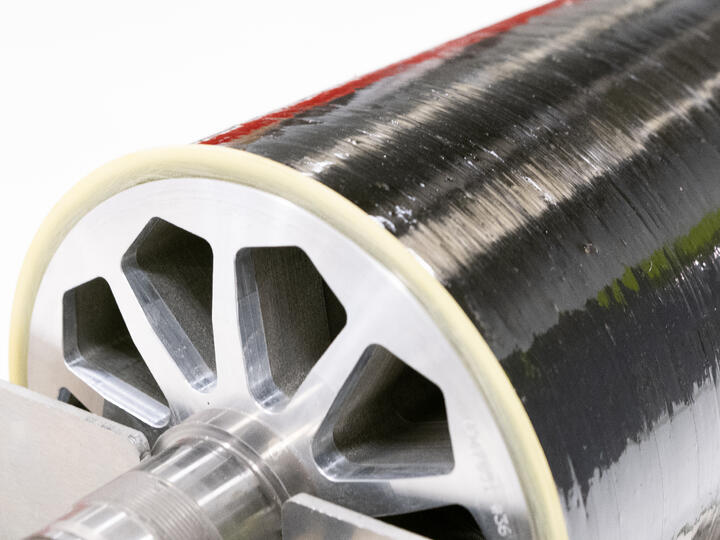New composites technology increases production rate for SME
Challenge
To devise and improve processes for an electric drive systems supplier, Magnetic Systems Technology, enabling high-volume manufacture of traction motors to capitalise on the forecasted increase in demand for its electric powertrains.
Background
Recent years have seen rapid uptake in electric vehicles to curb emissions, mitigate climate change and improve air quality. With tightening of regulations and expansion of low emissions zones in urban areas, commercial vehicle owners are steadily moving towards converting existing vehicles to battery electric.
Magnetic Systems Technology (Magtec) is a leading UK manufacturer and integrator of electric powertrains, supplying new and repowering commercial vehicles. Magtec, based in Rotherham, collaborated with the University of Sheffield Advanced Manufacturing Research Centre (AMRC) and other partners on a project aimed at scaling up the company's electric motor production to meet the surge in demand for battery-electric commercial vehicles.
The project focused on eliminating production bottlenecks and embracing new composite technologies to significantly increase Magtec’s production volume. Alongside the AMRC, the consortium included the Manufacturing Technology Centre (MTC), Angel Trains and Dennis Eagle Trucks.
This collaboration was part of a £5.5 million initiative, backed by a £2.6 million grant from the Advanced Propulsion Centre, which provides funding for the development of low emission transport solutions and automotive technologies – supporting the UK’s transition towards net zero product manufacturing and supply chain in the automotive sector. The AMRC, which is part of the High Value Manufacturing Catapult network of research centres alongside MTC, secured £350,000 of the total project value to help enhance Magtec’s production capabilities.
Innovation
The AMRC team focused on developing an improved filament winding process for the carbon fibre rotor sleeve, which keeps the magnets in position while spinning at high speed. A calculator was developed to estimate the inward pressure that the sleeve could apply with different fibre tensions, which ultimately limits the maximum operating speed. Through experimental trials, including microscopy and tensile testing, the team compared these results to Magtec's existing 'wet-wind' technique.
In addition, AMRC engineers investigated the influence of process parameters on throughput, provided insight using pre-impregnated fibres and optimised material usage and tension requirements via the calculator – helping Magtec with future production adoption.
The collaboration also involved creating a factory simulation and supply chain analysis using Siemens’ Tecnomatix Plant Simulation technology. AMRC engineers devised a baseline model that represented the facility’s current operations which was used to project further advancements in automation and new technologies.
By using discrete event simulation, the team evaluated the potential benefit of these process improvements and based on some initial assumptions, two models were created for review to support Magtec’s ‘Blueprint 5000’ target of creating 5,000 motors annually. As Magtec acquired new equipment based on these projections, AMRC continuously updated the simulation to ensure Magtec's production rate remained on track while simultaneously developing toolkits for supply-chain risk assessment.
A motor includes a rotator and a stator, both made up of sheets of steel, stacked and glued together. The AMRC undertook a desktop study to identify an improved assembly process for the components, looking at alternative lamination technologies.
Result
The outcomes of the project have positioned Magtec, the UK’s largest electric drive systems supplier, on a trajectory from producing 60 to 5,000 traction motors per year. The AMRC played a crucial role in supporting the supplier’s mission to enhance electric vehicle technology and production scalability through advanced composite and manufacturing technologies.
The collaboration between Magtec and AMRC led to the adoption of towpreg winding technology, significantly enhancing production efficiency by reducing setup times and increasing throughput. This method, pre-impregnating resin into the fiber, not only streamlines manufacturing but also ensures a more consistent and stable final product compared to the messier, time-consuming wet-winding process.
Use of virtual simulation helped integrate advancements to Magtec’s factory floor and provide estimations for the necessary workforce and machinery required to enable the business to reach ‘Blueprint 5000’. The virtual planning also allowed Magtec to understand essential materials and precautions needed to help validate and optimise production decisions and investment strategies.
Following the examination of rotator and stator assembly processes, the AMRC also provided recommendations on alternative lamination technologies that Magtec could adopt for future growth.
Impact
The collaboration with AMRC enabled Magtec to revolutionise its manufacturing process through the adoption of a new composites technology - towpreg winding - ensuring a cleaner and 35 per cent faster process that yields a more consistent product. The initiative de-risked the towpreg winding method, instilling confidence in its efficacy.
Through comprehensive evaluation and implementation of cutting-edge manufacturing processes, and factory simulation AMRC has been instrumental in shaping Magtec's industrial roadmap, embedding sustainable improvements that provide both immediate and long-term impacts while providing Magtec with a clear roadmap of ‘Blueprint 5000’, outlining a strategic path to achieving an ambitious build rate of 5,000 motors annually, representing a six-fold increase in capacity.

